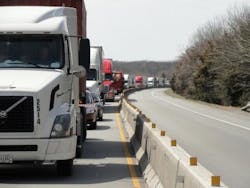The I-10 bridge collapse in the Mojave Sunday afternoon isn’t really a prime example of the growing national problem with failing infrastructure, although some folks with a keen interest in abundant highway funding likely will be screaming this week that the sky is falling. And while some wild-haired prophet might wander out of the wilderness, warning that a washout in the desert during a record-shattering drought is a sure sign of something or other, my metaphor of choice is “weakest link.”
The bridge, which supported eastbound traffic between Southern California and Phoenix, was built in 1967 and the 2014 National Bridge Inventory shows it as “functionally obsolete”—meaning it’s not built to current standards for lane width or vertical clearances, for instance. Otherwise, and other than being 50 years old—like much of the Interstate system—it’s your basic Southwestern wash crossing.
I mean, we’re not talking the Tappan Zee replacement here. CalTrans (who provided the video above) knows how to fix it, although a lot of workers will be reassigned for several weeks, I imagine.
The significance of the failure is that this is an entirely routine bit of roadway, knocked out by an unusual but not-unheard-of flash flood—and a major East-West artery is now blocked indefinitely. For vacationers, the detour is an inconvenience and the amount of pain is inversely proportional to the kids’ ability to amuse themselves for a little longer in the back of the mini-van.
Extrapolate, and we're talking some serious lost productivity.
So the I-10 washout isn’t the looming catastrophe—the next Minneapolis bridge collapse—that many have forecast, in the gruesome hope that Congress will commit to a substantial highway funding plan if failure to do so is made scary enough.
With the current highway authorization set to expire July 31, however, this is a timely and comparatively gentle reminder that the states need to know what to expect from the federal government. Mother Nature is unpredictable enough.





